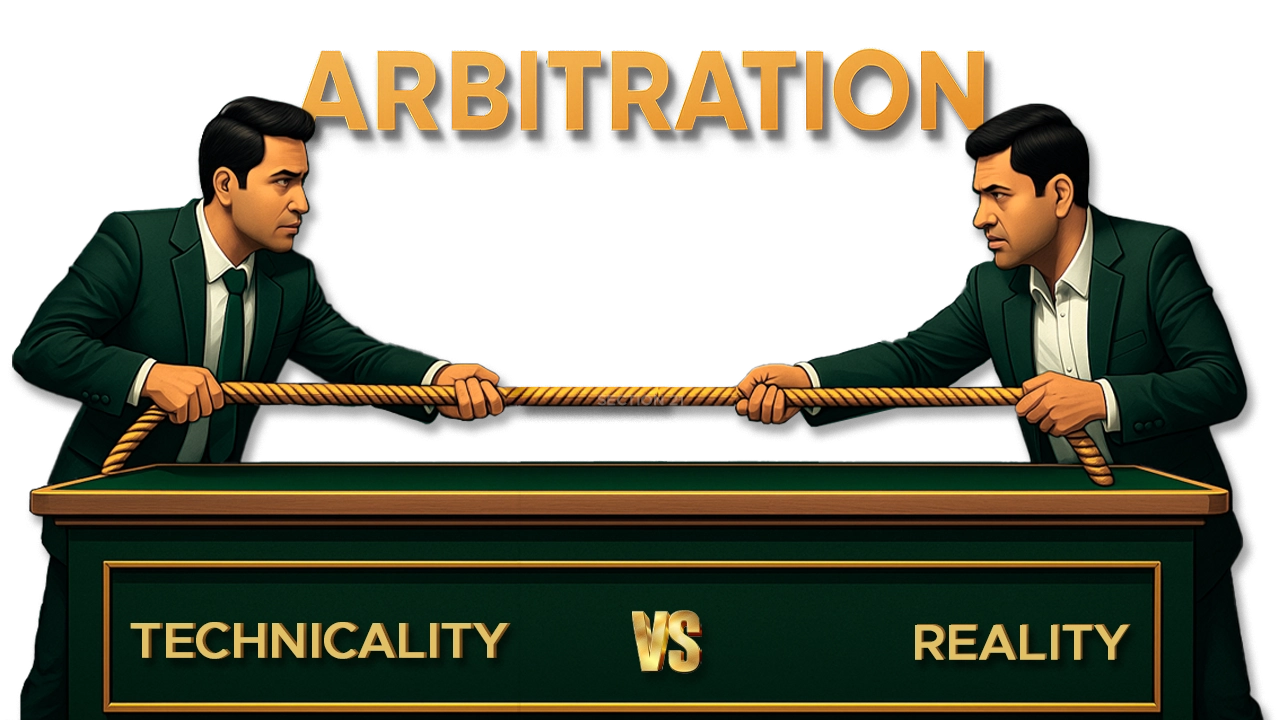Introduction
How far can a court stretch the principle of ‘substance over form’ when it comes to the technicalities of arbitration law? Imagine a scenario where a business dispute is raging, with multiple court filings clearly indicating one party’s intent to take the matter to arbitration. Both sides have actively engaged with the dispute’s nature and the possibility of arbitration. Yet, one party later argues that the subsequent application to appoint an arbitrator is invalid simply because the initial formal NIA1 under Section 21 of the A&C Act2, was never issued. Does the technical omission of a formal notice override the demonstrable fact that the other party was fully aware of the dispute being referred to arbitration?
The Rajasthan High Court Jaipur Bench, in a significant ruling in Sinsinwar Construction Company v. The Chief General Manager, BSNL3 by Justice Anoop Kumar Dhand, tackled this precise issue, holding that a petition under Section 11 of the A&C Act for the appointment of an arbitrator would be maintainable even in the absence of a formal Section 21 NIA, provided the Respondents were already well-aware of the dispute being referred to arbitration.
This pivotal decision arose from a dispute where the Respondents sought to dismiss the Section 11 petition, asserting its non-maintainability due to the lack of a valid Section 21 notice. The Petitioners, conversely, argued that the Respondents’ full knowledge of the entire dispute—evidenced, in part, by the fact that the trial court returned the Petitioner’s plaint under Order VII Rule 10 of the CPC4 only after the Respondent filed a Section 8 application—rendered the technical requirement of a fresh Section 21 notice superfluous.
The central legal conundrum before the Court was whether the mandatory nature of issuing a Section 21 notice can be circumvented by the doctrine of actual knowledge or waiver on the part of the Respondent. This article delves into the jurisprudential underpinnings of this judgment, closely examining the underlying legal principles of the A&C Act, the necessity of formal procedure versus the equity of substance, and the parameters that define ‘knowledge’ in the context of invoking arbitration, which ultimately formed the basis of this crucial judicial pronouncement.
When a borrower defaults, and a financial institution initiates recovery proceedings, the clock starts ticking not just on the loan, but often on a complex legal battle involving multiple statutes. Can a private, contractual mechanism like arbitration truly coexist with the powerful, public law remedies provided to banks and financial institutions, such as those under the DRT Act5 or the SARFAESI Act6?
This fundamental question—whether a dispute between a person and a financial institution regarding non-payment of a borrowed amount can be referred to an Arbitral Tribunal when the matter is already sub judice before the Debt Recovery Tribunal (DRT)—formed the first critical issue before the Court.
To navigate this highly sensitive legal terrain, the Court turned to the expansive judgment of the Hon’ble Apex Court in Vidya Drolia & Others v. Durga Trading Corporation & Others7. How did the Supreme Court define the limit of arbitration’s reach? The larger bench in Vidya Drolia meticulously examined the principle of non-arbitrability, particularly where a statute mandates adjudication by a specialized court or public forum. The core of the analysis rests on the Doctrine of Election. Is a party free to elect arbitration when a mandatory law provides a special forum? Vidya Drolia, drawing on earlier observations in Transcore v. Union of India8, clarified the three essential elements of the Doctrine of Election: two or more remedies, inconsistency between those remedies, and a choice of one. Crucially, the Supreme Court in Transcore held that the SARFAESI Act is an additional remedy to the DRT Act, and since they constitute, in effect, one consistent remedy for the financial institution, the Doctrine of Election does not even apply in that context.
Expanding on this, Vidya Drolia established a pivotal test: Does the mandatory law, by necessary implication, prohibit the parties from waiving adjudication by the designated court? The Court noted that when a statute creates a special right or liability and provides a specified public forum with unique powers of enforcement—remedies “beyond the ordinary domain of the civil courts”—arbitration is contraindicated. Why? Because the Arbitral Tribunal cannot effectively enforce those special rights or execute the award in the manner mandated by the special law.
In the context of the DRT Act, the Supreme Court made its position unequivocally clear. Reviewing the DRT Act as a “complete code by itself” for debt recovery, the Court highlighted the DRT’s unique and comprehensive modes of recovery. Consequently, Vidya Drolia expressly overruled the judgment of the Full Bench of the Delhi High Court in HDFC Bank Ltd. v. Satpal Singh Bakshi9, which had held that matters covered under the DRT Act were arbitrable. The binding pronouncement is this: Treating the claims of banks and financial institutions covered under the DRT Act as arbitrable would deprive and deny these institutions of the specific recovery rights and modes provided under that Act. Therefore, the claims covered by the DRT Act are non-arbitrable, as there is an implied prohibition against waiver of the DRT’s jurisdiction. The legislation, in this scenario, effectively overrides the contractual right to arbitration.
While the ruling on the DRT Act appears to shut the door on arbitration for debt recovery claims, a different dynamic applies to proceedings under the SARFAESI Act. Do the coercive enforcement proceedings under SARFAESI automatically render any underlying dispute non-arbitrable? The Court referred to the earlier Supreme Court decision in M.D. Frozen Foods Exports Pvt. Ltd. v. Hero Fincorp Ltd10. This judgment, reaffirmed in Indiabulls Housing Finance Limited v. Deccan Chronicle Holdings Limited11, clarified the fundamental difference between the two processes: SARFAESI proceedings are in the nature of enforcement proceedings, enabling financial institutions to take possession and sell secured properties, whereas Arbitration is an adjudicatory process—a mechanism for determining the existence and extent of the debt. The Supreme Court in M.D. Frozen Foods Exports categorically held that SARFAESI proceedings and arbitration proceedings can go hand-in-hand (or “parallelly”). The SARFAESI action addresses the secured asset and is about enforcement, while arbitration addresses the adjudication of the outstanding debt itself. Even if the secured assets are insufficient, a creditor can only proceed against other assets after the full debt amount is determined by a competent forum. Therefore, the objection that the Arbitration Clause (Article 23) of the loan agreement could not be invoked due to the ongoing SARFAESI proceedings was deemed contrary to the settled position of law. The Court effectively separated the adjudicatory (arbitration) function from the enforcement(SARFAESI) function, allowing them to coexist.
Having settled the non-arbitrability issue, the Court turned its attention to the judicial function at the stage of a Section 11application: What is the court’s scope of inquiry? This brings us to a complex interplay of Supreme Court precedents regarding the legislative intent behind Section 11(6A) of the A&C Act, which was introduced by the 2015 Amendment. This sub-section, which was later proposed to be omitted but remains in force pending notification, states that the court “shall… confined to the examination of the existence of an arbitration agreement.”
In Vidya Drolia, the three-judge bench held that the Patel Engineering dictum (which allowed for a detailed judicial review) was legislatively overruled and that the court’s jurisdiction was limited. However, a significant clarification was introduced by the Constitutional Bench of seven Judges in In Re: Interplay between arbitration agreement under the Arbitration and Conciliation Act 1996, and the Indian Stamp Act, 189912. Did the Supreme Court confirm the omission of Section 11(6A)? The Constitution Bench pointed out an error in the Vidya Drolia premise: Section 11(6A) has not been omitted as its omission was never notified by the Central Government. Therefore, the provision remains in full force. The Court’s duty is to give true effect to this legislative intent. The Constitution Bench clarified the distinction between the roles of the Referral Court (under Section 11) and the Arbitral Tribunal (under Section 16 – competence-competence): The Referral Court under Section 11 is confined to the “examination of the existence” of an arbitration agreement, which is a prima facie determination limited to formal validity (e.g., in writing) based on the plain language of Section 7, where the word “examination” denotes a limited, non-laborious inquiry, whereas the Arbitral Tribunal under Section 16 can “rule” on its own jurisdiction, including the substantive existence and validity of the arbitration agreement, where the word “ruling” connotes a full adjudication after admitting evidence.
This view, reinforced by the Supreme Court in Indian Corporation Limited v. NCC Limited13 and NTPC Limited v. SPML Infra Limited14, confirmed that the pre-referral jurisdiction of the court is very narrow. The primary inquiry is the existence and validity of the agreement, and the secondary inquiry is to weed out claims that are manifestly and ex facie non-arbitrable—the “deadwood.” As held in NTPC Limited and Magic Eye Developers Pvt. Ltd. v. Green Edge Infrastructure Pvt. Ltd. & OthersThe standard of scrutiny is only prima facie. Referral Courts must not undertake a full review of contested facts; they must only be confined to a primary first review. If there is even the slightest doubt about non-arbitrability, the Rule is to refer the dispute to arbitration. The legislative intent, as confirmed by the Constitutional Bench, is to uphold the doctrine of competence-competence by letting the arbitral tribunal decide the substantive issues.
In summary, the court was guided by the principle that while claims under the DRT Act are non-arbitrable due to legislative prohibition, parallel proceedings under the SARFAESI Act do not per se bar arbitration. Furthermore, “the court’s role in the referral stage is a limited, prima facie check—a gatekeeper role”—to ensure the existence of an arbitration agreement and to summarily reject only the most “manifestly and ex-facie non-arbitrable” claims, leaving all substantive disputes of validity and non-arbitrability to the chosen Arbitral Tribunal.
Conclusion
The judgment delivered by the Rajasthan High Court Jaipur Bench marks a significant step toward judicial pragmatism, prioritizing the substance of consent and knowledge of dispute over rigid procedural formalities, particularly the requirement of a formal Section 21 Notice Invoking Arbitration. By upholding the maintainability of the Section 11 petition where the Respondents were undeniably aware of the dispute being referred to arbitration, the Court has reinforced the fundamental principle that arbitration law should serve as an efficient dispute resolution mechanism, not a trap of technicalities. This ruling aligns with the broader legislative intent of minimal judicial intervention and the encouragement of arbitration, preventing sophisticated litigants from stalling proceedings based on purely technical, non-prejudicial omissions. However, this raises crucial questions: Does this ruling open the door to ambiguity regarding when exactly ‘knowledge’ is deemed sufficient, potentially leading to more factual disputes in referral courts? And how precisely will the judiciary draw the line between actual knowledge and the complete lack of a formal notice?
The more complex and far-reaching ramification lies in the Court’s exhaustive analysis of concurrent jurisdiction, particularly concerning financial disputes. By affirming the Supreme Court’s mandate in Vidya Drolia, the judgment firmly establishes a firewall: claims covered by the DRT Act are non-arbitrable due to the Act’s special, comprehensive enforcement rights that arbitration cannot replicate. Simultaneously, by relying on precedents like M.D. Frozen Foods Exports, it permits arbitration proceedings to run parallel to SARFAESI Act proceedings, recognizing the latter as mere enforcement actions rather than adjudicatory bars. This distinction is vital for financial institutions, clearly mapping out the boundaries of their contractual right to arbitrate against their statutory rights of recovery. Moving forward, will this clarity reduce litigation over jurisdictional overlaps, or might financial institutions try to compartmentalize debts even more finely to push the adjudicatory debt calculation into arbitration while simultaneously pursuing SARFAESI enforcement?
Ultimately, the article’s exploration of the Constitutional Bench’s clarification regarding Section 11(6A) anchors the entire discussion. By confirming that the provision remains in force, the judiciary’s role at the referral stage remains narrowly confined to a prima facie check—examining only the existence of the arbitration agreement and weeding out claims that are manifestly and ex-facie non-arbitrable. All deeper questions of validity, like the substantive existence or non-arbitrability, are reserved for the Arbitral Tribunal under the competence−competence doctrine. This firm stance against conducting a “mini-trial” at the pre-referral stage is perhaps the most significant takeaway, cementing the policy of promoting speed and finality in arbitration. The enduring question for the future, however, is: How effective will this prima facie standard prove to be in practice, particularly when dealing with complex, document-heavy agreements where the initial determination of ‘existence’ necessarily touches upon the agreement’s legal validity? The continuing evolution of the Indian arbitration landscape will depend heavily on the consistent and precise application of these principles.
Citations
- Notice Invoking Arbitration
- Arbitration and Conciliation Act,1996
- Civil Procedure Code,1908
- Recovery of Debts Due to Banks and Financial Institutions Act, 1993
- Securitisation and Reconstruction of Financial Assets and Enforcement of Security Interest Act, 2002
- Vidya Drolia & Others v. Durga Trading Corporation & Others(2021 (2) SCC 1)
- Transcore v. Union of India (2008) 1 SCC 125
- HDFC Bank Ltd. v. Satpal Singh Bakshi MANU/DE/5154/2017
- M.D. Frozen Foods Exports Pvt. Ltd. & Ors. v. Hero Fincorp Ltd., (2017) ibclaw.in 94 SC
- Deccan Chronicle Holdings Ltd. v. Indiabulls Housing Finance Ltd., (2018) ibclaw.in 55 HC
- In Re: Interplay between arbitration agreement under the Arbitration and Conciliation Act 1996, and the Indian Stamp Act, 1899 Arbitration Petition No. 25 of 2023
- Indian Corporation Limited v. NCC Limited SPECIAL LEAVE PETITION (CIVIL) Diary No.7028/2025
- NTPC Limited v. SPML Infra LimitedCIVIL APPEAL No. 4778 of 2022
- Magic Eye Developers Pvt. Ltd. v. Green Edge Infrastructure Pvt. Ltd. & Others(2024) ibclaw.in 223 HC
Expositor(s): Adv. Anuja Pandit






